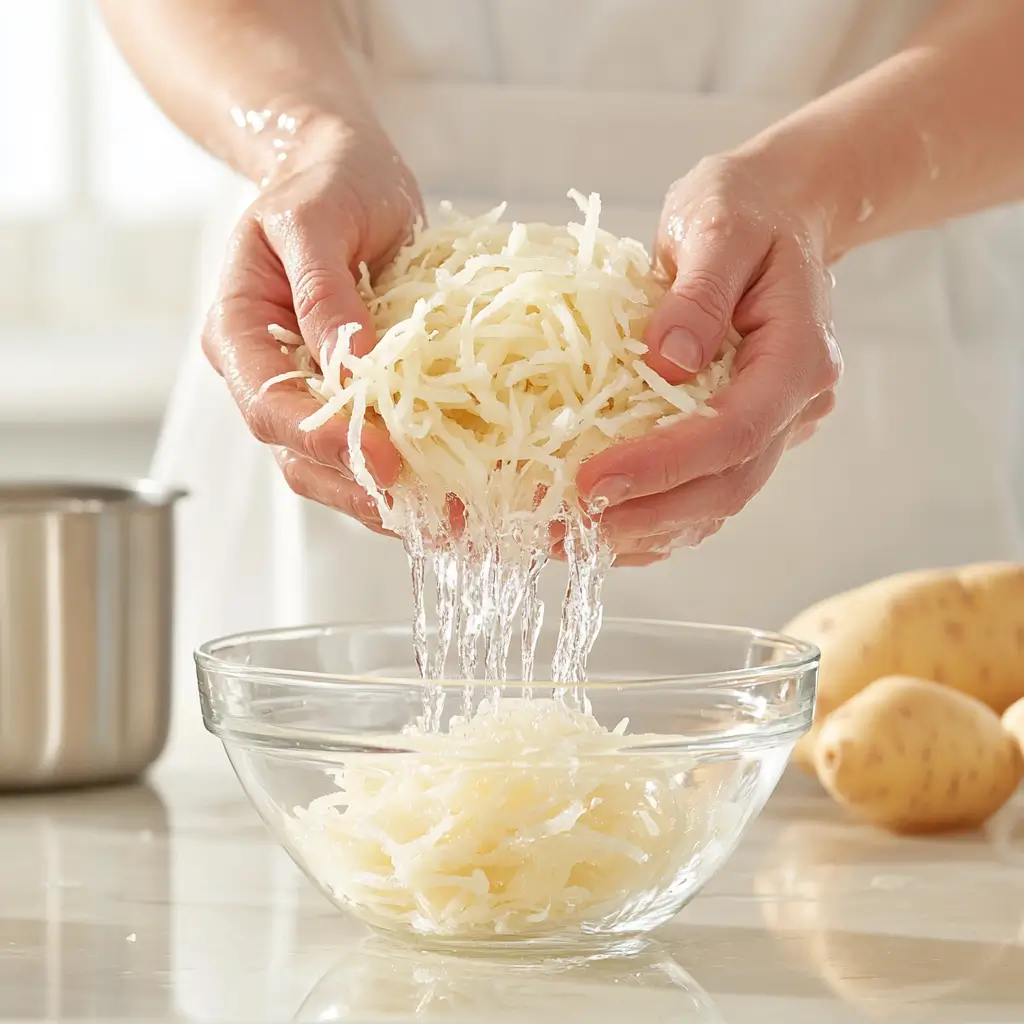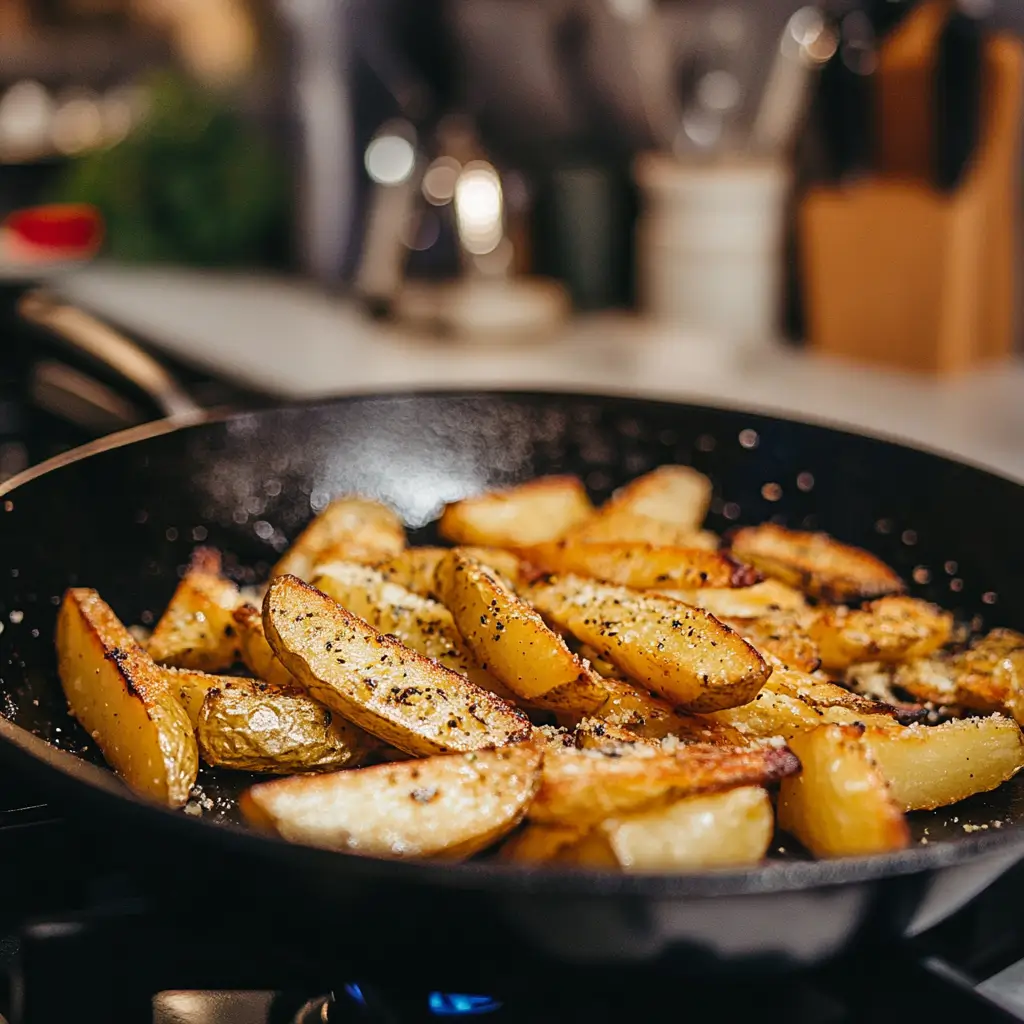Why won’t my hash browns get crispy? Crispy hash browns are a breakfast classic, loved for their golden-brown exterior and tender, flavorful interior. However, achieving the perfect balance of crispiness and texture can be surprisingly challenging. The hurdles lie in the nature of potatoes and the cooking process. Potatoes have high water content, which can make them soggy if not properly managed. Additionally, the starches in potatoes, while essential for binding, can cause clumping or uneven cooking when not handled correctly.
To make consistently crispy hash browns, it’s crucial to understand the science behind potato preparation, the role of temperature, and the importance of technique. From shredding to frying, every step can significantly impact the final product, making this seemingly simple dish a culinary challenge, leaving many to wonder, why won’t my hash browns get crispy?

Table of Contents
Understanding the Basics
Why Won’t My Hash Browns Get Crispy?
What Makes Hash Browns Crispy: The Role of Potatoes and Starch
The secret to perfectly crispy hash browns lies in controlling moisture and starch, the two critical factors that influence texture. Here’s a closer look at how these elements contribute:
Moisture Control:
Potatoes have a high water content, which is the primary obstacle to achieving crispy hash browns. Many people wonder, “Why won’t my hash browns get crispy?” The answer often lies in excess moisture.
When water remains in the shredded potatoes, it prevents the surface from browning and forming that golden, crispy texture during frying. This is a common frustration for those asking, “Why won’t my hash browns get crispy?”
The solution is to remove as much moisture as possible. Start by shredding the potatoes and pressing or wringing them out thoroughly with a towel or cheesecloth.
By eliminating this excess water, you address one of the main reasons why hash browns won’t get crispy. This step ensures the potatoes cook properly and develop a perfect, crisp surface..
The Role of Starch:
Potatoes naturally contain starch, a key element that influences the texture of your hash browns. However, excessive starch can cause clumping and uneven cooking. This often leads many to ask, “Why won’t my hash browns get crispy?”
Finding the right balance of starch is essential for achieving crispy hash browns. If you’re wondering, “Why won’t my hash browns get crispy?”, rinsing the shredded potatoes thoroughly in cold water can help.
This step removes excess surface starch, which prevents gumminess and ensures even cooking. By keeping just the right amount of starch, you allow the potato shreds to bind together. This approach helps solve the mystery of why your hash browns won’t get crispy, giving them that perfect crisp texture.
3. Potato Varieties:
The type of potato also matters. Starchy potatoes, like russets, are ideal for hash browns because they contain less moisture and more starch compared to waxy potatoes. This composition allows them to crisp up beautifully while maintaining a tender interior.
Common Issues with Hash Browns
Excess Moisture
One of the most common reasons people ask, “Why won’t my hash browns get crispy?” is excess moisture. Potatoes naturally have a high water content, which prevents browning and results in soggy hash browns. If you’re wondering, “Why won’t my hash browns get crispy?”, it’s likely because the shredded potatoes weren’t thoroughly dried before cooking. When water remains in the potatoes, it creates steam during cooking, stopping the surface from crisping. To solve this, vigorously squeeze the shredded potatoes using a kitchen towel, cheesecloth, or potato ricer. Removing as much water as possible is an essential step in answering the question, “Why won’t my hash browns get crispy?” and achieving that perfect, golden-brown texture.

Pan Heat
The temperature of your pan plays a crucial role in answering the question, “Why won’t my hash browns get crispy?” If the pan isn’t hot enough, the hash browns will absorb oil, resulting in a greasy texture instead of crispiness.
On the other hand, if the pan is too hot, the exterior may burn before the interior cooks through. This imbalance is a common issue for those wondering, “Why won’t my hash browns get crispy?”
The solution lies in maintaining proper pan temperature. Preheat your pan over medium to medium-high heat before adding oil or butter. To test if the pan is ready, sprinkle a drop of water on the surface—it should sizzle immediately.
By consistently keeping the pan at the right temperature, you prevent issues like sogginess or burning. This approach ensures an even, golden-brown crust and answers the question of why your hash browns don’t get crispy.
Oil Choice
If you’ve been asking yourself, “Why won’t my hash browns get crispy?”, it’s worth considering the type of oil you’re using. The choice of oil directly influences the texture and flavor of your hash browns. Oils with a high smoke point, like vegetable oil, canola oil, or clarified butter, are excellent for achieving that golden, crispy exterior without burning. While butter alone adds a wonderful flavor, its low smoke point can result in uneven browning or scorching. To ensure success, combine butter with a high-smoke-point oil. This method balances rich flavor with the heat stability needed to make your hash browns crispy and delicious, addressing the common issue of why hash browns sometimes fail to crisp up.
Potato Preparation
Improper potato preparation is often the answer to the question, “Why won’t my hash browns get crispy?” Skipping essential steps, such as rinsing the shredded potatoes in cold water, can leave excess starch on the surface, which leads to clumping and uneven cooking. By rinsing the potatoes thoroughly, you remove surface starch, allowing the shreds to stay distinct and crisp during cooking. After rinsing, it’s equally important to dry the potatoes thoroughly to avoid steaming, which prevents crispiness. Choosing the right potato variety also makes a difference. Starchy potatoes, like russets, are the best choice due to their low moisture content and high starch levels, creating the ideal conditions for crispy hash browns.
Overcrowding the Pan
If you’re wondering, “Why won’t my hash browns get crispy?”, the type of oil you’re using might be the reason. The oil plays a key role in determining both the texture and flavor of your hash browns. Oils with a high smoke point, such as vegetable oil, canola oil, or clarified butter, are best for achieving a crispy, golden-brown exterior without burning. While butter brings a rich, savory flavor, its low smoke point can cause uneven browning or scorching when used alone. To solve the issue of “Why won’t my hash browns get crispy?”, try combining butter with a high-smoke-point oil. This approach blends flavor and functionality, ensuring your hash browns come out perfectly crispy every time.
Step-by-Step Guide to Perfect Hash Browns
Proper Potato Selection
Choosing the right type of potato is one of the most important steps to answer the question, “Why won’t my hash browns get crispy?” Russet potatoes are the top choice for crispy hash browns due to their high starch content and low moisture levels. These characteristics make them ideal for forming a golden, crispy exterior while keeping the interior light and fluffy. On the other hand, waxy potatoes, like red or Yukon Gold, contain more moisture, which often prevents them from crisping up properly. If you’ve been struggling with why your hash browns won’t get crispy, starting with the right type of potato can make all the difference in achieving the perfect result.
Grating
Grating the potatoes into fine, even shreds is essential if you’ve been wondering, “Why won’t my hash browns get crispy?” Using a box grater or a food processor with a shredding attachment ensures consistency in size. Finer shreds cook more quickly and evenly, resulting in a cohesive hash brown with a perfectly crispy texture. Larger shreds, on the other hand, may cook unevenly and lead to less satisfactory results.
Rinsing
Rinsing the grated potatoes in cold water removes excess surface starch, which can cause clumping or gummy hash browns. Place the grated potatoes in a large bowl of cold water and swish them around with your hands to release the starch. Repeat the process until the water runs clear. This step ensures each shred remains distinct and contributes to a crispy texture.
Drying
Properly drying the potatoes is one of the most critical steps in achieving crispy hash browns. Excess moisture prevents browning and leads to steaming instead of frying. After rinsing, place the shredded potatoes in a clean kitchen towel or cheesecloth, then twist and squeeze firmly to remove as much water as possible. For best results, spread the squeezed potatoes on a dry towel and pat them further to ensure no moisture remains.
Cooking Techniques

- Preheat the Pan:
Use a large, heavy-bottomed skillet (preferably cast iron or nonstick) to distribute heat evenly. Preheat the pan over medium to medium-high heat before adding oil or butter. A properly heated pan is key to creating the crispy crust. - Choose the Right Fat:
Use an oil with a high smoke point, like vegetable, canola, or avocado oil. For added flavor, combine oil with butter. Heat the fat until it shimmers or the butter begins to foam, signaling it’s ready for the potatoes. - Form a Thin Layer:
Add the shredded potatoes to the pan in a thin, even layer. Press down lightly with a spatula to encourage even contact with the surface. Avoid overcrowding the pan, as this will trap steam and prevent crispiness. - Cook Undisturbed:
Let the potatoes cook undisturbed for 4–5 minutes, or until the bottom develops a deep golden-brown crust. Avoid flipping too early; patience is key to crisp perfection. - Flip and Finish:
Once the bottom is crispy, carefully flip the hash browns using a spatula. Cook the other side for another 4–5 minutes until equally golden and crisp. - Drain and Serve:
Remove the hash browns from the pan and place them on a paper towel-lined plate to absorb any excess oil. Season immediately with salt and serve hot for the best texture.
Troubleshooting Hash Brown Problems
How to Fix Common Mistakes Like Sogginess and Uneven Cooking
Even with careful preparation, hash browns can sometimes go awry. Whether they turn out soggy, unevenly cooked, or greasy, there’s often an easy fix. Let’s address these common problems and how to solve them:
Sogginess
Problem: Excess moisture prevents the hash browns from crisping up, leaving them soft and greasy.
Fix:
- Squeeze Out More Water: After grating the potatoes, thoroughly wring them out using a clean kitchen towel or cheesecloth. If sogginess persists, repeat the process until no water drips out.
- Rinse and Dry Properly: Rinse the shredded potatoes to remove surface starch and dry them completely. Any remaining water will cause steaming instead of frying.
- Cook in Smaller Batches: Overcrowding the pan can trap moisture, so cook the hash browns in thin, even layers to allow for proper crisping.
Uneven Cooking
Problem: Some parts of the hash browns are crispy while others remain undercooked or mushy.
Fix:
- Spread Evenly: After adding the potatoes to the pan, spread them in a uniform layer. Press lightly with a spatula to ensure even contact with the cooking surface.
- Use Consistent Heat: Keep the heat at medium or medium-high. High heat may burn the edges before the center cooks, while low heat can leave the hash browns limp.
- Flip with Care: Flip the hash browns only once, ensuring the bottom is fully cooked before turning. This helps both sides cook evenly.
Clumping or Falling Apart
Problem: The potatoes stick together in large clumps or fall apart when flipping.
Fix:
- Rinse Away Excess Starch: Surface starch causes sticking and clumping. Rinse the shredded potatoes thoroughly in cold water until the water runs clear.
- Use Enough Fat: Ensure the pan is well-coated with oil or butter to prevent sticking. Let the fat heat up fully before adding the potatoes.
- Press Gently: When forming the layer of potatoes, press them down gently, not too hard, to maintain structure without over-compacting.
Greasy Texture
Problem: The hash browns absorb too much oil, making them greasy and heavy.
Fix:
- Preheat the Pan and Oil: A properly preheated pan helps seal the surface of the hash browns quickly, preventing excess oil absorption.
- Use Minimal Fat: Avoid overloading the pan with oil. A thin coating is sufficient for crisping the potatoes without greasiness.
- Drain Excess Oil: Once cooked, place the hash browns on paper towels to absorb any remaining oil.
Burning Before Crisping
Problem: The exterior burns before the hash browns develop a proper crust.
Fix:
- Adjust the Heat: Lower the heat slightly to allow the potatoes to cook through evenly. Medium to medium-high heat works best.
- Monitor Cooking Time: Avoid rushing the process. Let the hash browns cook undisturbed for several minutes on each side until a golden crust forms.
- Add Fat Gradually: If the pan starts to dry out, add a small amount of oil or butter to prevent burning without oversaturating the potatoes.
FAQs
Addressing Common Questions About Hash Brown Preparation
1. Why are my hash browns soggy instead of crispy?
Soggy hash browns are usually caused by excess moisture in the potatoes. After shredding, squeeze out as much water as possible using a towel or cheesecloth. Rinse the shreds in cold water to remove excess starch, and dry them thoroughly before cooking. Avoid overcrowding the pan, as this can trap steam and prevent crisping.
2. Do I need to peel the potatoes before making hash browns?
Peeling is optional. The skin adds texture and a rustic look to hash browns. However, if you prefer a smoother texture or want a more uniform appearance, peel the potatoes before shredding.
3. Can I use pre-shredded or frozen hash browns?
Yes, but with precautions:
- Pre-shredded potatoes: Ensure they are as dry as possible before cooking.
- Frozen hash browns: Thaw completely and pat them dry to remove excess moisture. Frozen options are convenient but may lack the freshness and flavor of freshly shredded potatoes.
4. What’s the best oil for frying hash browns?
If you’ve ever wondered, “Why won’t my hash browns get crispy?”, the type of oil you use might be the key. Oils with high smoke points, such as vegetable, canola, or avocado oil, are perfect for frying hash browns because they help achieve a crispy, golden-brown crust without burning. For added flavor, you can combine butter with the oil. Since butter alone burns quickly, this mix allows you to enjoy a rich flavor while still ensuring the hash browns get crispy.
Conclusion
Achieving consistently crispy hash browns is a rewarding process that combines careful preparation, the right techniques, and attention to detail. Here’s a summary of the key tips to perfect your hash browns every time:
- Start with the Right Potatoes:
Use starchy potatoes like russets for their ideal moisture and starch balance, which promotes crispiness. - Prep Thoroughly:
Shred potatoes evenly, rinse them to remove surface starch, and dry them completely to avoid sogginess. - Use Proper Heat and Fat:
Preheat your pan to medium or medium-high and cook with a high-smoke-point oil. Add butter for flavor, but balance it with oil to prevent burning. - Spread Thin and Cook Evenly:
Form a thin, even layer of potatoes in the pan and resist the urge to flip too soon. Allow time for a golden crust to develop before turning. - Avoid Overcrowding:
Cook in batches to ensure each shred gets proper contact with heat, preventing steaming and sogginess. - Season After Cooking:
Add salt and other seasonings once the hash browns are done to maintain their crisp texture.
With patience and these simple techniques, you can create hash browns that are perfectly crispy on the outside and tender on the inside. Practice makes perfect, and soon, you’ll be enjoying restaurant-quality hash browns from your own kitchen!
